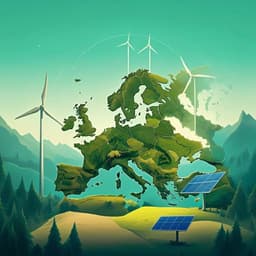
Environmental Studies and Forestry
Energy requirements and carbon emissions for a low-carbon energy transition
A. Slameršak, G. Kallis, et al.
This research investigates the energy requirements and emissions associated with 14 low-carbon mitigation pathways required to meet the Paris Agreement goals. Conducted by Aljoša Slameršak, Giorgos Kallis, and Daniel W. O'Neill, the study reveals an initial net energy decline and significant transition emissions that could consume the remaining global emissions budget by 2050. Discover how energy modeling can shape our future pathways!
~3 min • Beginner • English
Introduction
The IPCC’s Special Report on Global Warming of 1.5 °C indicates that the 1.5 °C target remains achievable and presents multiple pathways to reach it. Yet, a key unknown is how much energy and associated greenhouse gas emissions are required to build and maintain a low-carbon global energy system. Prior research has raised concerns that lower energy return on energy invested (EROI) for renewables could reduce net energy available to society and risk an energy-emissions trap during rapid decarbonisation. Life-cycle assessment (LCA) studies have quantified technology-specific impacts but typically for present-day cases and rarely in a dynamic, system-wide context. Existing dynamic analyses (e.g., for power plants only) suggest substantial emissions but cover only electricity, roughly 20% of final energy, and single transition pathways. This study addresses these gaps by quantifying the energy required for the energy system itself and its associated emissions across fourteen 1.5 °C-consistent global mitigation pathways, separating energy/emissions for the energy system from those available for other societal uses, and dynamically modelling changes in EROI and carbon intensities over time.
Literature Review
The literature debates whether a low-carbon transition reduces net energy due to potentially lower EROI of renewables compared to historical fossil-fuel systems, though recent work argues fossil fuel EROI has been overestimated and renewable EROI underestimated, with renewable EROI likely improving and fossil EROI declining. LCA has been widely used to estimate climate impacts of energy technologies, but most studies are static and technology-specific. Pehl et al. integrated dynamic LCA with an IAM for power plants, estimating 82 GtCO2e (2010–2050) from construction/operation/maintenance, while Di Felice et al. estimated 25 GtCO2e for the EU’s renewable electricity decarbonisation (2020–2050). These focus on electricity only and single pathways. There is also discussion of an energy-emissions trap, potential constraints from materials supply, and IAMs’ possible biases toward CCS/BECCS and underrepresentation of intermittent renewables and dynamic EROI effects.
Methodology
The study defines “energy for the energy system” as energy required for construction (including decommissioning), operation, and maintenance of energy supply infrastructure and for transporting energy carriers to end-users. Net energy at the final energy stage equals total final energy minus energy for the energy system. The analysis applies net energy/EROI accounting at the final energy boundary consistently across energy carriers and technologies. It covers 27 energy conversion technologies and four carriers (electricity, gases, liquids, solids) from 2020–2100. EROI assumptions combine present-day literature estimates (with consistent boundaries from extraction to point-of-use) and projections using energetic experience curves for technologies like wind, solar PV, and electrolysis. Three EROI scenarios are constructed: high-EROI (rapid improvements for renewables; bioenergy around median), median-EROI (moderate improvements; median bioenergy), and low-EROI (slower renewable improvements; low bioenergy), with a gradual decline in fossil EROI towards present-day lower quartile values. Energy requirements are decomposed into extraction/refining/transport (for fossil/biomass fuels), and construction, operation and maintenance, and decommissioning (for all technologies). Construction energy is estimated via energy intensity of capital multiplied by technology-specific capital costs and new capacity additions; O&M energy via energy intensity times O&M cost per energy generated; decommissioning is 10% of construction energy at end-of-life. Extraction energy uses standardized EROI at resource-gate (EROIST) values and technology conversion efficiencies; refining energy for oil and biomass uses literature energy intensities; transport energy uses global trade-route distances and mode-specific energy intensities from LCI databases. For non-biomass renewables and nuclear, lifetime energy requirements are split between construction/decommissioning and O&M based on EROI, capacity factor, lifetime, and a technology-specific ratio linking O&M to construction energy; dynamic EROI improvements are applied to wind and PV. The overall system EROI at final energy stage is computed as gross final energy divided by total energy requirements across all technologies, minus one. Energy system emissions are calculated as the product of energy-for-energy-system by carrier and the time-varying carbon intensity of each carrier (electricity, gases, liquids, solids), distinguishing construction, operation/maintenance, and decommissioning phases. Carrier carbon intensities evolve with the share of conventional fossil fuels over time, using emissions data from the pathways (electricity) and carbon intensity parameters for non-electric carriers. Negative emissions from BECCS are reported separately and not used to reduce carrier carbon intensities; positive upstream emissions for BECCS outside of biomass supply and fertiliser use are not fully included. Fourteen 1.5 °C-consistent pathways (RCP1.9) are analysed, including four IPCC illustrative pathways (LED, S1-A, S2-M, S5-R) and ten additional pathways from Rogelj et al. Results are reported for low/median/high EROI scenarios. A panel OLS regression with time fixed effects assesses drivers of energy system emissions using final energy, share of conventional fossil fuels, and share of energy for the energy system (1/EROSYS) as predictors, with robust standard errors.
Key Findings
- Cumulative energy system emissions are substantial: fourteen-pathway average of 195 GtCO2 (median-EROI), ranging from 185 GtCO2 (high-EROI) to 290 GtCO2 (low-EROI). Across pathways and assumptions, emissions range approximately 70–395 GtCO2. This corresponds to about 21% of total cumulative emissions on average under median-EROI assumptions (20% high-EROI; 31% low-EROI).
- Among illustrative pathways (median-EROI): LED ~70 GtCO2 (12% of total), S5-R ~220 GtCO2 (20% of total). Slower decarbonisation with higher energy use and larger BECCS deployment yields higher energy system emissions.
- Share of energy system emissions in total emissions rises over time: fourteen-pathway average increases from ~10% (2006–2015) to 27% in 2050 and 40% by 2100 (median-EROI). Under low-EROI: ~12% to 39% (2050) to 59% (2100); high-EROI: ~9% to 26% (2050) to 31% (2100). In some pathways, the energy system exhausts all residual emissions by ~2080, leaving none for hard-to-abate sectors.
- Upfront transition does not cause a large short-term spike: in S5-R, average 2020–2030 energy system emissions are 4.0 GtCO2/yr (median-EROI), about 1.0 GtCO2/yr above 2006–2015, i.e., <3% of 2020 total CO2. In S1-A, the increase is ~0.6 GtCO2/yr (2020–2030). Rapid fossil phase-out quickly reduces energy system emissions (from ~2025 in S1-A/LED).
- Technology choices matter: prioritising rapid fossil phase-out and renewables/nuclear over bioenergy (especially BECCS) lowers cumulative energy system emissions; emissions from renewables converge toward zero as electricity decarbonises, whereas BECCS-related emissions persist longer and are higher per unit energy due to low EROI and high supply-chain energy needs.
- Net energy declines during transition: per capita net energy falls across all pathways, with rapid-decarbonisation/low-demand pathways (LED, S1-A) seeing ~28–34% drop by 2030 vs 2015. Slower-decarbonisation pathways (S2-M, S5-R) exhibit smaller, later, and temporary declines (e.g., ~10% by 2040 vs 2030).
- Drivers of energy system emissions: during 2020–2040, higher final energy use strongly correlates with higher energy system emissions; a 100 EJ increase in annual energy use associates with ~0.8 GtCO2/yr higher energy system emissions. After 2040, the share of conventional fossil fuels becomes the dominant driver; the association with 1/EROSYS (share of energy for the energy system) weakens.
- Climate impact scale: 195 GtCO2 of energy system emissions equates to roughly five years of 2021 global CO2 emissions and implies ~0.1 °C additional warming, small relative to the long-term benefits of rapid decarbonisation.
Discussion
The study directly quantifies the energy required to build and operate the energy system during 1.5 °C-compatible transitions and the associated emissions, thereby clarifying how much of the remaining emissions budget is occupied by the transition itself. Findings show these emissions are material yet manageable relative to the benefits of rapid decarbonisation; the feared short-run ‘emissions spike’ from scaling renewables is modest, while slower decarbonisation with extended fossil use and heavy reliance on BECCS leads to larger, more persistent energy system emissions that compete with residual emissions needs in hard-to-abate sectors. The rising share of emissions devoted to the energy system indicates that the energy sector decarbonises more slowly than the overall economy in many pathways, potentially stressing residual emissions allocations. Technology choices decisively shape outcomes: pathways prioritising renewables and nuclear over bioenergy and CCS achieve lower energy system emissions and often improving overall EROI. Even with declines in net energy, improved end-use efficiency and demand-side measures can maintain or improve access to energy services. Integrating explicit energy-for-energy-system accounting and dynamic EROI into IAMs would produce more internally consistent pathways and may shift technology portfolios toward lower upstream energy/emission options.
Conclusion
A comprehensive accounting of energy requirements and emissions for the energy system reveals that the transition itself consumes a meaningful share of energy and carbon budget: roughly 195 GtCO2 on average across 1.5 °C pathways, with the share of total emissions for the energy system rising significantly over time. Short-term emission increases from building low-carbon infrastructure are small, and rapid decarbonisation with strong renewable deployment minimises cumulative energy system emissions. Net energy per capita declines temporarily, especially under fast decarbonisation and lower demand, but service levels can be maintained through efficiency and demand-side shifts. Future research and modelling should explicitly incorporate dynamic EROI and energy system emissions into IAMs, consider alternative normative scenarios, and extend analysis to consumption-end transformations (e.g., EVs, charging, storage) and material constraints, to better capture trade-offs and inform technology choices that limit energy system emissions.
Limitations
- BECCS-related positive emissions are incompletely captured: the analysis excludes several upstream components (e.g., land-use change, full supply chain emissions beyond biomass supply and fertiliser use), likely underestimating energy system emissions in bioenergy-heavy pathways (S2, S5).
- Use of global average EROI and technology parameters ignores regional heterogeneity in resources, technologies, and supply chains.
- Material constraints and supply-chain bottlenecks for rapid renewable/nuclear scale-up are noted but not explicitly modelled.
- IAM scenario data are used for energy mixes and emissions; questions remain about how well IAMs represent upstream emissions and dynamic EROI effects.
- End-use capital stock turnover and associated energy/emissions (e.g., vehicles, charging, storage) are not included.
- Several parameterisations (e.g., energy intensity of capital, transport intensities) rely on literature averages and assumed constancy or simplified dynamics, introducing uncertainty.
Related Publications
Explore these studies to deepen your understanding of the subject.







